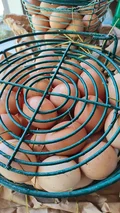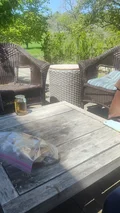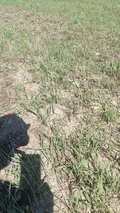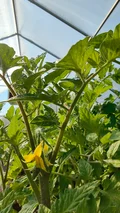TL;DR
It was a pretty typical day on the farm with a small crew today. We washed 83 dozen eggs, hoed in the dry fields, then planted more onions. Things are starting, growing, and establishing…veg and weeds alike.
More Eggs on the Way
The last time we processed eggs was Tuesday, so there was an abundance of them today in the walk-in fridge. Every time eggs are done, we write the number down in a records book hanging on the wall in a row labeled by week. If eggs are done more than once a week, we write separate numbers and add them once the week ends.
There should be 300 more chickens coming soon. We’ll need them since we have to provide at least 140 dozen per week for the 20 weeks of the CSA. But it would likely be more like 175-200 dozen per week to support special events, additional purchases by CSA members, and eventually the general store in Essex (not until Aug/Sept at least).
I asked about whether we should also keep track of the broken ones, about 5-10% of the typical take, because in my mind if there’s an unexpected uptick it might suggest either more light shells due to diet or something in the handling process. Jamie said trends are good, but blips are unimportant.
Trends vs. Blips
There are a lot of things going on at a farm at all times. Once farms lock normal modes of operations in and know what they’re doing, there’s a lot less variance in outcomes. There are some details which are terribly important…usually health and safety are the top areas where it matters. Lots of other things don’t matter like I expect them to, in part because nature has a way of working out many kinks and also I haven’t earned enough context and experience over so many things that I just don’t have an intuition for which things matter and which things dont yet.
So the conundrum is: how can you observe trends without measuring things, and if you don’t know which details matter and which don’t, how can you measure the right things and not the wrong ones? This is very much also a problem in modern software and large-scale organizational leadership. If you haven’t earned the context and experience, you don’t what issues are ‘blips’ (momentary outliers) and which one’s are trends. I’ll think on this more, but it seems like something I want to imbue into IEEE 2675.2 which I’m majorly contributing to within a working group.
After Lunch, A Three-Point Glitch
A hitch, and ditch, and a glich walk into a sitch…okay, over the weekend the tractor in the main field got stuck in some unexpectedly soft soil…with a film mulcher attached to its 3-point hitch. Jamie and I (mostly Jamie) tried to get the hitch detached but to no end. Eventually he had to get the big tractor from the dry field (which had to come up to the main field anyway) to tow the smaller tractor out.
Hoe, Hoe, Hoe Your Rows
Today, the activity that felt the most like a lesson in pain was hoeing a row of scallions over in the dry (not irrigated) field. The soil there crusts over without mulch and the (grass) weeds grow pretty quickly. We hadn’t hoed there since we planted a few weeks ago and there were many patches where the weeds were almost completely indistinguishable from the small scallion shoots.
I’ve worked in other farm settings where they hoe almost every day, as regular as greenhouse watering and egg washing. Tis’ the season for hoeing anyway, but this was especially painful because some of these roots are well established even after cultivation by a tractor and attachment. Also the spacing and alignment of planting was ‘wonky’ in this row (I remember when this was happening and worried a bit on the inside).
We are currently using stirrup hoes and since the soil is full of rocks, they don’t stay sharp for very long. There are so many types of hoes and even handles with hoe heads that can be swapped out depending on what type of head is most useful in particular circumstances. So far, I’ve worked with the following types of hoe heads:
- Stirrup
- Colinear
- Cape Cod Weeder
- Beet/Nursery Hoe
- Scuffle Hoe
- Wire Weeder(s)
I think the stirrup hoes are good in this field because of the rough, dry soil but I’d like to try others and certainly maintain their sharpness with a metal file in pocket along the way next time. I’d love to get my hands on a Lehman’s precision Amish style garden hoe, but I have to earn my experiences with what we have before drooling over upgrades already.
Planting Short Rows of Onions
We finished out the day planting about 20 trays of onions in two not-complete rows because the lower part of the dry field is inconsistently mucky after the past few days of on-and-off rain. We’ve got maybe about 20-30 98-cell trays of onion starts left outside the greenhouse and the end is in sight. After all is done, we’ll have planted 4 varieties of about 13,500 onions.
My neck and back and leg and shoulder muscles hurt just thinking about it. And this isn’t even a very large CSA farming operation. One day, one row, one plant at a time.
This Week in My LLM Work
I didn’t get to much of the fun stuff last Friday or this weekend because I fell down a deep, dark hole related to disk WRITE performance of Github public runners. The reason for the need for disk writing throughput at all, not to mention network I/O, is because early on in my work on this blog I violated my own conscience about including the photos as Git LFS blobs with my commits. Yes, yes…I know how to use git and what not to use if for, but I didn’t think I’d need to share too many photos and, well, now I know better.
My plan is to move all my images to Cloudfront backed by an S3 bucket. This will solve my main problem, but bifercate my content publishing process a bit and I’ll have to write some shell scripts and overhaul the Github Actions pipeline. I might also end up entirely building the site locally to create a Jekyll ‘_site’ contents folder and just to an rsync-style differential upload to S3.
When I asked ChatGPT for a solution to Jekyll large file/media assets, it didn’t provide much useful info. After a beer on Sunday with my friend Amin who said all of his sites are static Jekyll in S3 fronted by a CDN, and my own “bless me father for I have sinned” about betraying my own values by committing images to a Git repo, I am ready to convert as a weekend project.
Today’s response from my existing LLM infrastructure about what I did is below:
Main Themes: Physical labor and exhaustion, technical issues with farm equipment, teamwork and communication, and challenges of working in dry fields.
Activities Done by the Intern:
- Watering greenhouse (45 minutes)
- Washing eggs for 3.5 hours
- Loading truck with onions
- Dropping off at dry field with Jamie
- Hauling weeds (three-point hitch got stuck)
- Riding back to get another tractor
- Hoeing scallions in a dry, non-irrigated field
- Planting onions in lower, wet part of dry fields
New Things Not Yet Encountered:
- Using three-point hitch on a tractor
- Hauling weeds with stirrup hose
- Hoeing scallions in a dry, non-irrigated field
- Using film organic to cover rows for planting
Questions and Future Areas of Research:
- How to deal with weeds taking over scallions?
- Benefits and challenges of using three-point hitch on tractors in dry fields?
- Why Jamie suggested losing a bet to weeds was not the end of the world?
Suggested Actions:
- Wearing gloves or using tools to protect yourself from hazards while hoeing
- Implementing irrigation systems in dry fields
- Exploring alternative methods for weeding, such as different tools or techniques.
[end of post]
Enjoy Reading This Article?
Here are some more articles you might like to read next:







